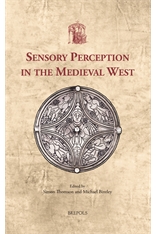Sensory Perception in the Medieval West, ed. S. Thomson and M. Bintley (Turnhout, 2016: USML 34), x+254 pp. ISBN 978-2-503-56714-3.
An interdisciplinary exploration of the sensory experiences invited and explored by textual and material products of the medieval period.
What was it like to experience the medieval world through one’s senses? Can we access those past sensory experiences, and use our senses to engage with the medieval world? How do texts, objects, spaces, manuscripts, and language itself explore, define, exploit, and control the senses of those who engage with them?
This collection of essays seeks to explore these challenging questions. To do so is inevitably to take an interdisciplinary and context-focused approach. As a whole, this book develops understanding of how different fields speak to one another when they are focused on human experiences, whether of those who used our sources in the medieval period, or of those who seek to understand and to teach those sources today.
Articles by leading researchers in their respective fields examine topics including: Old English terminology for the senses, effects of the digitisation of manuscripts on scholarship, Anglo-Saxon explorations of non-human senses, scribal sensory engagement with poetry, the control of sound in medieval drama, bird sounds and their implications for Anglo-Saxon sensory perception, how goldwork controls the viewing gaze, legalised sensory impairment, and the exploitation of the senses by poetry, architecture, and cult objects.
Contents:
Simon C. Thomson, “Sensory Perception in the Medieval West: Introduction”
Richard North, “Heaven Ahoy! Sensory Perception in The Seafarer”
Jonathan Wilcox, “The Sensory Cost of Remediation; or, Sniffing in the Gutter of Anglo-Saxon Manuscripts”
Mariana Lopez, “The York Mystery Plays: Exploring Sound and Hearing in Medieval Vernacular Drama”
Eric Lacey, “Birds and Words: Aurality, Semantics and Species in Anglo-Saxon England”
Simon C. Thomson, “’Whistle while you work’: Scribal Engagement with Old English Poetic Texts”
Victoria Symons, “Doing things with words: Language and Perception in Old English Charms and Riddles”
Francesca Brooks, “Sight, Sound and the Perception of the Anglo-Saxon Liturgy in Exeter Book Riddles 48 and 59”
Melissa Herman, “All that Glitters: The Role of Pattern, Reflection, and Visual Perception in Early Anglo-Saxon Art”
Patricia Skinner, “Taking Out the Eye of a One-Eyed Man and Other Hypothetical Moments of Sensory Impairment in Early Medieval Law”
Pete Sandberg, “Disembodied Cognition and Sensory Perception in Sólarljóð”
Meg Boulton, “(Re-) Viewing “Iuxta Morem Romanorum“: Considering Perception, Phenomenology and Anglo-Saxon Ecclesiastical Art and Architecture”
Michael D.J. Bintley, “Plant Life in the Poetic Edda”
Index


